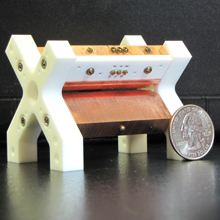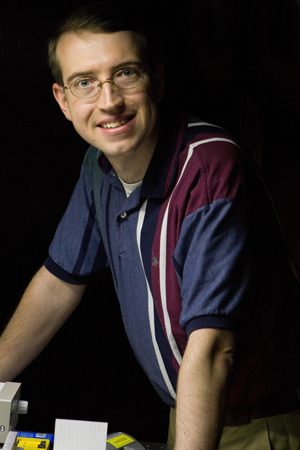By Katherine Duke ’05
The research that takes place in David Hanneke’s lab in Merrill Science Center involves a lot of cool stuff: lasers, crystals, electromagnetic traps, the fundamental constants of the universe and Amherst College students. Now Hanneke, an assistant professor of physics, has a five-year, $600,000 CAREER grant from the National Science Foundation (NSF) to support his team’s ongoing investigations into the properties of charged particles.
Over the past 20 years, largely as part of the effort to develop quantum computers and better atomic clocks, scientists have refined ways to isolate individual charged atoms in electromagnetic traps and to control each atom’s quantum state. In between earning his Ph.D. from Harvard in 2008 and joining the Amherst faculty in 2011, Hanneke worked as part of the National Institute of Standards and Technology’s Ion Storage Group to conduct experiments on such trapped atoms. Now, in his lab at Amherst, he plans to trap not just an individual charged beryllium atom but, along with it, a charged diatomic molecule, which can “do a lot more things than an atom does. For example, it can vibrate back and forth, and it can rotate around itself,” he says. He is trying to develop techniques to control these molecules at the quantum level.

Part of the small electromagnetic trap in which Hanneke's research team will isolate particles
Once he and his student researchers have trapped both an atom and a molecule, the team will direct particular frequencies of light from a laser into the trap to make the particles move. Because they are charged, they repel each other, and pushing on the molecule makes the atom move as well. By making precise measurements of the atom’s response, they can learn about how the molecule itself is behaving. One long-term goal is to measure how much energy it takes to make the molecule “leap” to a different quantum state. And because this energy depends upon certain fundamental constants, another goal is to determine—by observing the molecule, or a series of identical molecules, for a year or more—whether the fundamental constants, particularly the ratio between the mass of the electron and the mass of the proton, actually change over time. (No known laws of physics allow this ratio to change, Hanneke explains, but certain recent theories suggest that it might.)
The first phase, though, has been setting up the trap and other research apparatus. As part of her senior thesis last year, Celia Ou ’13 shined an infrared laser beam through a specially cut piece of bismuth borate (Hanneke jokingly calls it a “magic crystal”), which increases the beam’s frequency, converting it to blue light. Thesis student Shenglan Qiao ’13 designed the electrodes that will create the electric field in which the particles will be caught; the electrodes were built in the machine shop in Merrill. This summer, Cheyenne Teng ’14E, Phyo Kyaw ’14, Julian Ricardo ’15 and Ned Kleiner ’16 are working in Hanneke’s lab on such tasks as assembling a vacuum enclosure for the trap and designing circuitry to control the laser.
Undergraduate involvement is an important component of Hanneke’s grant. “The Faculty Early Career Development (CAREER) Program … offers the National Science Foundation’s most prestigious awards in support of junior faculty who exemplify the role of teacher-scholars through outstanding research, excellent education and the integration of education and research within the context of the mission of their organizations,” the NSF’s website explains.

“I think it’s exciting to be able to do this sort of work with the students in a small-college setting,” Hanneke says. “A research environment requires a very different sort of pace and skill set than the coursework.”
As part of the grant, Hanneke will dedicate some of his time to reviewing and revising the physics curriculum at Amherst, to better serve students who major in it and those who take physics courses as part of the premed program—as well as those who try out a few courses just because physics is cool.
Hanneke portrait by Rob Mattson